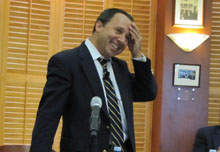
September 14, 2010— Pulitzer Prize–winning journalist and nonfiction author of The Way of the World and The One Percent Doctrine, Ron Suskind spoke at a Shorenstein Center event about “Truth-telling versus Message Control: A Dilemma for Sources and Reporters.”
There has been a shift in focus on the perception of the message rather than on the truth of the message that has lead to a “bent toward the power of the image, creating a new set of effects,” said Suskind. The challenge for reporters then, he said, was the commodification of access, with the Bush administration “gauging the supply very carefully and demanding a lot for its exchange.”
“What we do as journalists—when it works—is in direct opposition to the cult of message control,” Suskind said. “It is impossible to get around the ever-enveloping net that brings journalists in, providing them access, to simply get various versions of message through a variety of mouthpieces.” This kind of journalism is “less than what’s needed in terms of our role and our charge,” he said.
The “underlying bargain” for journalists, according to Suskind, is that the penalty for “violating the code” and affronting the authoritative message is loss of access. However, Suskind suggested that newspapers should reward and protect those journalists with courage to speak out against the managed message. He also pointed out that message management is “not specific to party, but specific to power and how it is exercised in this era.”
Suskind is hopeful that “people in the mix” will continue to speak the truth despite powerful persuasion to do otherwise. “The concept of message management is to treat sources like children,” Suskind said, making them “read the script, follow the playbook.” But Suskind pointed out that people “want their acquired insights and earned wisdom” to be heard. When that happens, the “powers-that-be will be deeply aggrieved” and will try to cut off your access and try to discredit you; but, Suskind says, “that shows you’ve done something right.”
This article was written by Janell Sims and the photos taken by Leighton Walter Kille, both of the Shorenstein Center.

